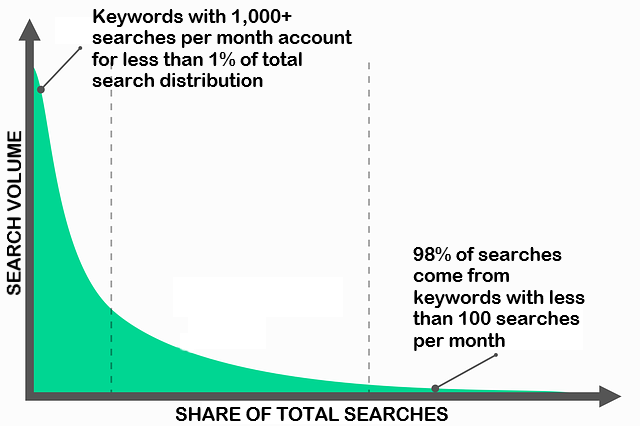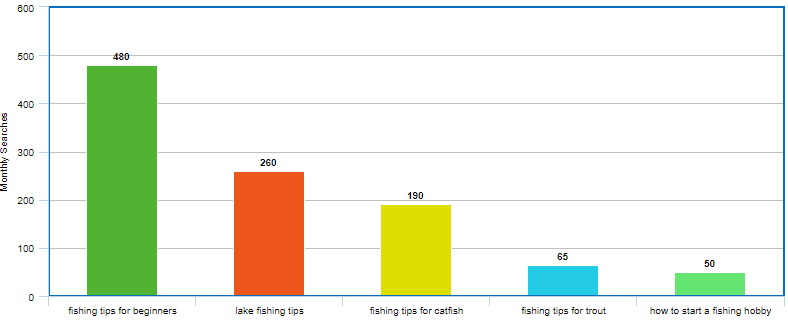Long Tail Keywords What Are They For and How Do We Use Them?
Keyword research is one of the first steps of any successful SEO campaign. One pitfall that a lot of people fall into, however, is focusing too much on the high competition keywords that are difficult to rank for.
They get mesmerized by a high search volume, and fail to take into account just how hard it will be for their site to get in front of those 57,000 searchers every month. And they don’t even consider if the keyword suggests any sort of profitable intent from the searcher.

The solution for these keyword research woes is using long tail keywords. These low hanging fruit are easy to compete for because most in SEO overlook them, and they generally convert better than shorter keywords. In this post, we’ll show you exactly why.
What Exactly Are Long Tail Keywords And How Do You Use Them?
Long tail keywords or LSI (latent semantic index) keywords are pretty much exactly what you would expect: keywords with more words in them; they have a “long tail”. Generally, at least 3, but it gets a little more nuanced than that.
You see, the term “long tail” is actually a reference to an analysis of the distribution of keyword searches. It turns out that the keywords that get the most searches per month have the smallest total share of searches.

In fact, keywords with 1000 or more searches per month account for less than 1% of the total number of search engines results.
The long tail of the graph is that thin line composed of keywords with less than 100 searches per month. While these low volume phrases are generally not valued very highly in SEO, they account for 98% of the total share of internet searches.
To put that a little bit more simply, if there were only 100 people conducting searches on Google, 98 of them would be searching for longtail, low volume keywords.
Any given “head keyword” (the term for phrases with high search volume) is going to have its own search demand curve that mimics this pattern. For example, the broad keyword fishing tips (4,400 monthly searches) has any number of long tail keywords that decrease in search volume but still fall under the same topical umbrella:

This is Where Most SEOs Go Wrong
The conventional keyword research wisdom in the SEO community is that the best approach to keyword research is to find keywords with high search volume and low competition.
The first problem with that is… those 2 things are rarely married. While not the case 100% of the time, often the very fact that keywords have a high search volume makes it an appealing target to people doing SEO and therefore more competitive.
It also does not take into account keyword intent.
For example the keyword “gold” has 1.2 million searches per month… but it doesn't give you any idea what the searcher is actually interested in.
However long tail keywords such as “Buy gold backed IRA accounts” “how to invest in gold” have dramatically less search volume, but actually have a clear purchasing intent and are therefore far more valuable.
Most SEOs would ignore keywords like this, but if you build out a website with a lot of easy to pick off long tail keywords yo can easily and build up a lot of warm – hot organic traffic that will lead to sales and you being able to brag to your friends about your SEO skills.
What Are The Benefits of Using Long Tail Keywords?
So, now you understand that long tail keywords are what most people are searching for on the internet. While individually, any long tail keyword doesn’t account for very much search traffic, collectively they add up big time within a given niche.
With that in mind, here are several of the benefits of using long tail keywords.
Long Tail Keywords Have Strong User Intent
The reason for long tail keywords having such a large share of the search is because they account for the way people actually search for things online.
While millions of people might be interested in “auto repair” on any given day, most of them are searching for very specific things, like “how to fix a flat tire” or “how do I know if my car battery is dead”.
When you target long tail keywords, you can have a very clear idea of what your user is hoping to get from the results and direct your SEO content likewise.
For example, this post you are reading right now is targeting the term “long tail keywords for SEO”, which allows us to focus much more narrowly than a post that was targeting “keyword research” or “SEO strategy”, or even for “long tail keywords”.
Do Long Tail Keywords Convert Better?
Since long tail keywords predict a stronger intent from the user, that means they also convert better. In fact, web pages targeting long tail keywords convert at 26% on average, compared to just 10% for pages based around more general search terms.
It’s easy to understand why.
Someone searching for “shoes” or even “men’s shoes” doesn’t have the same level of commercial intent as someone who googles “business casual men’s sneakers”.
So targeting long tail keywords doesn’t just mean that you’ll have an easier time ranking. It also means there will be more value to the traffic you do bring in.
Will Long Tail Keywords Help You Rank For More Competitive Search Terms?
While those big volume head keywords might not convert as well, traffic is traffic. Eventually, they should be a long term goal within your SEO strategy. And long tail keywords are perfect for helping you move the needle on more competitive terms.
Google isn’t going to rank you for “personal finance” unless it thinks you’re an authority in the niche. The more you are bringing in traffic for terms like “budgeting tips for college students”, “how to save for a family vacation”, and “best apps for financial planning”—the more Google is going to recognize your site as an authoritative source.
So How Do You Use Long Tail Keywords?
In the end, long tail keywords are the linchpin to a successful content marketing strategy. By focusing the keywords you research around low competition search terms with crystal clear user intent, you are going to rank more easily and drive more targeted traffic.
Your long tail keywords should drive your blog content. Behind all long tail keywords is a user looking for a specific type of information. The more you can create quality content that gives users what they need, the better chance you’ll have of ranking.
At the same time, you can also use long tail keywords as ideas for what should go into a broader post. For example, if you are doing a mega skyscraper article on How to Train a Dog, you could include sections or sprinkle sentences targeting long tails that naturally fit, like these:
- easy dog training strategies
- tips for potty training puppies
- how to train a dog not to bite
- training a dog in an apartment
In other words, long tail keywords reveal user intent, and therefore form a solid base for the type of content you need to create.
Not All Long Tail Keywords are Created Equally
One thing to keep in mind is that just because a keyword has low search volume doesn’t necessarily mean it’s not competitive.
Take the term “how to lose weight during pregnancy if obese”. This only gets 10 searches per month and seems like an incredibly narrow keyword. It should be easy to rank for, right?
Not when the first page of the SERPs includes sites like Healthline, ScienceDaily, and the Chicago Tribune—all with a domain authority in the 90s.
In this case, it’s because our keyword is really just a synonym for a more general search term. The same pages that rank for this one also rank for more competitive terms like “obese and pregnant” and “obese pregnancy”.
Some Final Thoughts About Long Tail Keywords
So, as you go forward and start using your newfound knowledge of long tail keywords, just remember that not all long tails are created equally. You've got to evaluate the competition just like any other type of keyword research, and what long tail keywords are for.
Longtail keywords are a great way to target a more specific user intent, especially for E-commerce and affiliate websites. Check out the best affiliate marketing programs for beginners, if you haven't quite chosen a niche yet.





